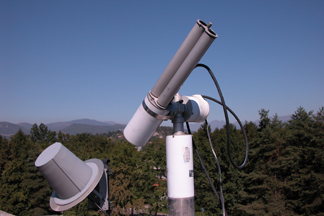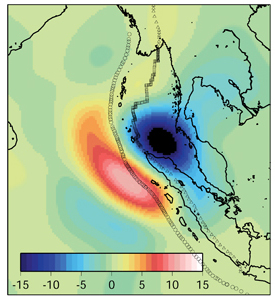|
Geophenomena
Small particles pack big climate punch
Satellites see post-SUMATRA seafloor shifts
Small particles pack big climate punch
 Tiny airborne particles called aerosols play a significant role in climate change, but whether they counteract or reinforce the impact of greenhouse gases is still unclear. Aerosols can both absorb sunlight and build radiation-reflecting clouds, thereby either helping to heat up or to cool down the atmosphere. Now, however, a new study of aerosols’ effect on climate weaves together those competing effects, as a first step to understanding how the particles affect the atmosphere.
Tiny airborne particles called aerosols play a significant role in climate change, but whether they counteract or reinforce the impact of greenhouse gases is still unclear. Aerosols can both absorb sunlight and build radiation-reflecting clouds, thereby either helping to heat up or to cool down the atmosphere. Now, however, a new study of aerosols’ effect on climate weaves together those competing effects, as a first step to understanding how the particles affect the atmosphere.
A sunphotometer in Ispra, Italy, scans the sky and measures solar radiation reaching Earth’s surface. Using solar absorption as a proxy for the concentration of small particles in the atmosphere, scientists are able to make better estimates of how the particles affect Earth’s climate. Photograph is by Giuseppe Zibordi.
Aerosols, emitted into the atmosphere from smoke and pollution, have garnered increasing attention from climate change scientists in the past 10 years, says Ilan Koren, an atmospheric scientist at the Weizmann Institute of Science in Rehovot, Israel. “We’ve known for a long time that we are emitting a huge amount of particles to the atmosphere from car pollution, industrial pollution and biomass burning,” in addition to natural aerosols such as dust and sea spray, he says. Once considered only an “elegant nuance” in climate models, he says, aerosols are now recognized as important players in the field of climate change.
Estimating aerosols’ impact, however, has proven to be anything but straightforward. “It’s hard to give just one number for the ‘aerosol effect,’ because you have two different types of physics playing here,” Koren says. “It depends heavily on chemical composition and environment.”
Within the cloud, he says, microphysics takes over: The aerosol particles become nuclei, or seeds, for condensation, helping to form more droplets and build more sunlight-reflecting clouds. Outside the cloud, however, the aerosols soak up solar radiation, and how much they absorb depends on the type of particle. Black carbon from soot or forest fire smoke, for example, is “our worst enemy in terms of absorption,” Koren says. By absorbing radiation, such particles warm the atmosphere, making it more stable and thereby inhibiting cloud formation, he says.
To better assess the overall aerosol effect, Koren and Yoram Kaufman, an atmospheric scientist at NASA’s Goddard Space Flight Center in Greenbelt, Md., analyzed data collected over seven years by AERONET, a network of ground-based instruments called sunphotometers. Established by NASA and other collaborators, the sunphotometers measure how much sunlight the aerosols absorb, as well as how much sunlight radiation is scattered by the atmosphere. By measuring both processes, the researchers were able to sidestep measurement errors due to moisture variability and cloud formation unrelated to aerosols.
The study, published in the Aug. 4 Science, found that the overall effect of aerosols was to increase cloud cover by about 5 percent, Koren says. Basically, “the microphysical effect wins the war,” he says. “We have more clouds due to aerosols on a global scale.”
Developing one global number to “define” the aerosol effect may not be a useful approach, however, because aerosols are short-lived in the atmosphere, and their heating or cooling effect is therefore local, Koren says. Unlike greenhouse gases, which remain in the atmosphere for one to 100 years — long enough to become well-mixed across the globe — aerosols survive only days before raining out, he says.
The important point, he says, is not to determine an overall number for aerosols’ impact, but to have a way to estimate their local effects. Those effects, Koren notes, can still have a larger, radiating impact, by ultimately affecting the distribution of energy and the water cycle.
Kaufman and Koren’s study “puts some order in something that has been very chaotic,” says Lorraine Remer, a climatologist with NASA Goddard’s MODIS aerosol project. By using solar absorption as a proxy for aerosol concentration, the authors have provided a way for scientists to much more easily measure aerosols from place to place, she says.
The finding is still only a “first step” that should be confirmed with other data and with models, Remer notes. “There’s still so much uncertainty,” she says. But “this paper shows how important the aerosol effect is.”
Carolyn Gramling
Satellites see post-SUMATRA seafloor shifts
 With a giant shudder, the December 2004 earthquake off the coast of Sumatra shook up the world — quite literally. The magnitude-9.2 temblor not only produced deadly tsunami waves that devastated coastal regions around the Indian Ocean, but also permanently redistributed Earth’s mass. Mapped by satellites, those shifts in Earth’s surface are now visible for the first time.
With a giant shudder, the December 2004 earthquake off the coast of Sumatra shook up the world — quite literally. The magnitude-9.2 temblor not only produced deadly tsunami waves that devastated coastal regions around the Indian Ocean, but also permanently redistributed Earth’s mass. Mapped by satellites, those shifts in Earth’s surface are now visible for the first time.
After the December 2004 Sumatra earthquake, GRACE satellites observed increases (red) and decreases (blue) in Earth’s gravity field on either side of the Java Trench (open circles). Gravity (measured here in microGal) increased where the seafloor lifted and the crust pushed down and compressed the mantle, and decreased where the crust stretched. Image is from Han et al., SCIENCE 313:658-662 (2006). Reprinted with permission from AAAS.
To assess the shifting in the rocks along a 1,300-kilometer (800-mile) rupture in the Java Trench off Sumatra’s western coast, Shin-Chan Han, a geophysicist at Ohio State University in Columbus, and his team used data from NASA’s Gravity Recovery and Climate Experiment (GRACE) mission. GRACE consists of two orbiting satellites that carry instruments that continuously monitor Earth’s gravity and track its variations. Scientists use changes in the satellites’ orbits as a proxy to measure variations in Earth’s gravity field — and the massive Sumatran quake created minute, but noticeable, changes in the distance between the two satellites.
To assess how the gravity variations reflect permanent mass changes within Earth as a result of the quake — as opposed to periodic climate and ocean-related changes — Han and his team compared the satellite-measured gravity changes around southeast Asia and the Indian Ocean from February to May 2003, January to June 2004 and January to June 2005. Between 2003 and 2004, the researchers observed little change in gravity in the region, but when they compared the data from 2005 with data from both 2003 and 2004, they observed two distinct shifts: a decrease in the gravity field on the eastern side of the Java Trench and an increase in gravity farther to the west and south.
As reported in the Aug. 4 Science, those anomalies reflect both physical shifting and density changes following the earthquake. On the eastern side of the trench, a decrease in gravity indicates reduced mass in the region due to Earth’s crust extending during the earthquake, Han says. On the opposite side of the trench, the gravitational increase is probably the result of two factors, he says: the abrupt uplift of the seafloor, which shifted seawater away and replaced it with denser crust; and a simultaneous downward push of the crust into the mantle. That “down-warping” compressed the mantle, making it denser, he says.
Han and his team hope eventually to use satellite observations of gravity changes to help forecast future major earthquakes by detecting early, pre-quake stirring in Earth’s crust, Han says. However, he notes, current accuracy limitations of the data mean that GRACE’s observations would, at this point, only be useful for the rarest, “great” earthquakes.
Carolyn Gramling

 Subscribe
Subscribe

